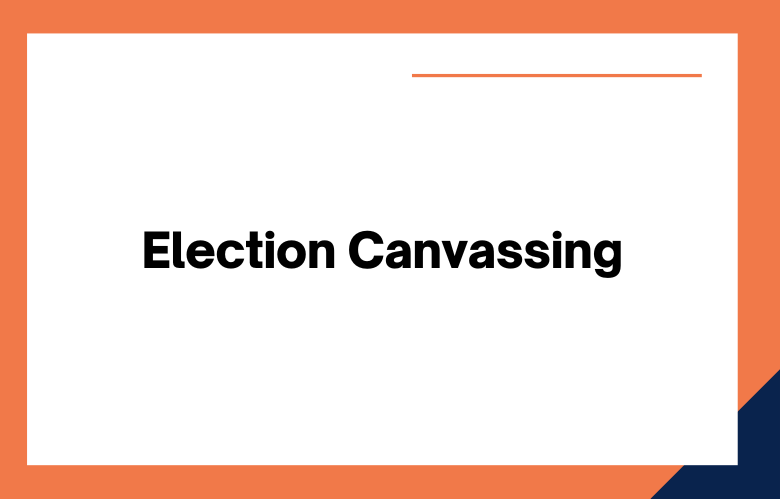Election canvassing is a critical component of any political campaign. It’s one of the most effective ways to introduce your candidate, their platform, and their message directly to potential voters.
By having direct conversations with people in the community, campaigns can increase voter turnout and build support for their candidate. But what do you need to know about election canvassing? Let’s take a look.
Election canvassing is an invaluable task for any political campaign. It involves sending a team of volunteers door-to-door to spread the word about the candidate, their platform, and how to vote.
Canvassing is a great way to reach potential voters directly and build relationships that can benefit them in the long run. Consider what you need to know about canvassing for your political campaign.
What is Election Canvassing?
Election canvassing is a grassroots effort conducted by campaigns where volunteers knock on doors or distribute literature to engage potential voters and get out the vote.
This type of campaigning has been used since the 19th century when politicians rode on horseback to spread their message.
Today, political campaigns use election canvassing as one of their primary outreach methods because it allows them to interact with individuals on a personal level and build relationships that can help increase voter turnout.
At its core, election canvassing is about getting out into the community and engaging with potential voters.
It typically involves going door-to-door or calling up people to encourage them to support your candidate.
Canvassers are also responsible for collecting information about the people they talk to, such as their age or party affiliation, which can be used by campaigns to target their messaging better.
Why is Canvassing Important?
Canvassing is the most effective way for candidates to connect with potential voters in their district or state.
It allows them to communicate directly with people who may not otherwise be exposed to their message via television or radio advertisements, social media posts, or traditional mailers.
It allows volunteers to learn more about the critical issues to constituents so they can adequately represent their candidate’s views when speaking with others.
How to Canvas Effectively
Preparing is the key to successful Canvassing—you must plan before knocking on doors!
Ensure your team understands who they represent and what topics to address when talking with constituents.
Ensure they have access to all necessary materials, such as flyers and sample ballots, so that they can provide all relevant information regarding your candidate’s platform and upcoming elections.
Provide training sessions, so your team knows how best to handle situations like hostile homeowners or individuals uninterested in hearing from you—this will ensure that everyone feels comfortable talking about your campaign, even if it doesn’t always go perfectly!
How Election Canvassing Works
Election canvassing relies on face-to-face conversations between volunteers and members of the public.
Often wearing t-shirts or carrying signs with their candidate’s name or logo, volunteers approach people in public spaces such as parks or shopping malls or knock on doors in residential neighborhoods.
During these conversations, volunteers explain why they support the candidate and think the public should vote for them.
In some cases, volunteers may also ask potential voters to commit to voting for the candidate by signing a petition or agreeing to be contacted again closer to Election Day.
Why Election Canvassing Matters
Canvassing is an essential tool that campaigns use to build awareness and support for their candidates.
With a dedicated team of canvassers out in the field talking directly with members of the public, many campaigns would be able to get their message heard amidst all the noise from other candidates.
Equally important is that Canvassing provides campaigns with valuable data they can use throughout their campaign—information such as which neighborhoods are most supportive of their candidate and which issues are most important to potential voters.
This data helps them target messaging more effectively and prioritize where they spend time during the campaign.
What You Need to Know about Election Canvassing
If you’re thinking about organizing an election canvass for your political campaign, there are a few things you need to keep in mind:
First, make sure your team has clear instructions before heading out into communities;
Second, ensure that everyone knows who they will be talking to (i.e., potential supporters vs. undecided voters);
Third, make sure that everyone involved understands local laws governing electioneering;
Fourth, use technology like tablets or smartphones when possible so that you can collect detailed data quickly;
Fifth, follow up after each conversation so you can track progress over time and
Finally, listen closely and adjust your messaging based on feedback from people in each community you visit — this will save you lots of time down the road!
Why You Should be Canvassing
Canvassing is an incredibly effective way to reach out to voters.
As opposed to traditional forms of campaigning such as television ads or mailers, which can be expensive and time-consuming, Canvassing is relatively low cost. It allows you to engage directly with potential voters.
Canvassers can speak with potential voters individually and answer any questions they may have about issues or candidates in the race.
This direct engagement has proven time and again to be an incredibly effective way to garner support for a political candidate or cause. Furthermore, it helps build relationships between communities and campaigns that can help ensure future success for both parties.
What You Need for Successful Canvassing
The most important thing you need for successful Canvassing is enthusiasm. You should never forget that you are representing your candidate or your cause—and people will respond positively if you show that you genuinely believe in what you’re advocating for!
Ensure your volunteers are trained on all relevant information before entering the field to be prepared to speak with voters.
Ensure that your volunteers stay safe while canvassing by following COVID-19 safety protocols and ensuring they have all the necessary tools (e.g., masks and hand sanitizer) before heading out on their route each day.
Make Sure Election Canvassing Done Right.
There are a few things you should remember when organizing an effective canvassing effort:
• Make sure your team has access to all the necessary materials before they go out into the field – this includes maps of the area they’ll be covering as well as contact information for local officials or other resources in case something goes wrong
• Have someone on hand who knows the ins and outs of how things work – this could be a seasoned veteran or even just someone familiar with your district who can offer guidance and advice if needed
• Use technology wisely – using tools like GPS tracking systems or online databases can help streamline and organize your efforts, making them more efficient and allowing you to reach more people faster
Conclusion
Election canvassing is an integral part of any political campaign because it helps drive people to connect directly with potential voters to build awareness and support for their candidates.
By having face-to-face conversations with public members using clear instructions and appropriate technology tools like tablets or smartphones – while also understanding local laws related to electioneering – campaigns can gain valuable insight into which issues are important and who might be interested in supporting their candidate come to Election Day!
More information gathered through practical canvassing efforts now leads to more informed decisions and greater chances at success come Election Day!
Canvassing is the most critical aspect of any election campaign.
Understanding how to canvass effectively ensures that your candidate has a strong chance of winning on Election Day.
If you need help with your campaign, contact our political Campaign Consulting team.
We specialize in helping candidates win elections by providing expert advice and analysis throughout the entire process, from strategy to data management.
Contact us today to learn how we can help you win your next election!
Call: +91 9848321284
Email: [email protected]
Election Canvassing: FAQs
What Is Election Canvassing?
Election canvassing is a strategic outreach activity in which campaign workers engage directly with voters through door-to-door visits or phone calls to influence voting decisions and collect data.
Why Is Canvassing Important In Political Campaigns?
It allows campaigns to build personal connections, persuade undecided voters, identify supporters, and gather valuable voter insights in real-time.
What Are The Main Types Of Election Canvassing?
The primary types include door-to-door canvassing, phone banking, digital canvassing (via social media or email), and street canvassing.
How Does Door-To-Door Canvassing Work?
Volunteers or campaigners visit households to introduce the candidate, discuss policies, answer questions, and encourage voter turnout.
What Tools Are Used For Election Canvassing?
Campaigns often use voter databases, mobile apps, GPS tracking tools, predictive dialers, and CRM platforms to organize and track canvassing efforts.
How Is Voter Data Collected During Canvassing?
Data is collected through scripted conversations, surveys, or digital forms and helps segment voters based on support level, issues of interest, and turnout likelihood.
Is Digital Canvassing Effective?
Yes, digital canvassing via email, messaging apps, or social platforms offers scale and cost-efficiency, especially when targeting younger or tech-savvy voters.
What Should A Canvasser Say To A Voter?
They should introduce themselves, explain their purpose, highlight key campaign messages, and respectfully and concisely ask for support or feedback.
How Can You Train Volunteers For Effective Canvassing?
Provide role-playing sessions, scripts, FAQs, voter data handling training, and motivation techniques to ensure confidence and consistency.
What Is The Best Time To Canvass Voters?
Evenings and weekends are most effective when people are likely to be home and available to talk.
What Is A Turf In Canvassing?
A turf is a defined geographic area assigned to canvassers to cover, usually organized by streets or voting precincts.
How Do You Measure Canvassing Success?
Metrics include contact rate, persuasion rate, voter turnout among contacted voters, and supporter sign-ups or donations generated.
Can Political Canvassing Be Automated?
Yes, through phone dialers, SMS campaigns, and AI-powered bots for digital interactions, though personal contact still yields higher conversion.
How Do You Handle Hostile Or Uninterested Voters?
Remain calm and respectful, and exit the interaction without confrontation. Focus energy on persuadable or supportive voters.
What Is The Difference Between Canvassing And Campaigning?
Campaigning includes broader activities like advertising, rallies, and PR, whereas canvassing focuses specifically on voter contact and persuasion.
How Is A Canvassing Script Prepared?
It should include an introduction, campaign message, key talking points, questions for voters, and an ask (e.g., vote pledge, donation, or volunteering).
What Is Voter Persuasion In Canvassing?
It’s changing or reinforcing a voter’s opinion through one-on-one conversations, usually by addressing concerns and highlighting candidate strengths.
Are There Laws Governing Political Canvassing?
Regulations vary by region and may cover door-to-door permissions, data privacy, do-not-contact lists, and public space use.
How Does Canvassing Impact Voter Turnout?
Studies show canvassing can increase turnout significantly, especially among low-propensity voters when contact is personal and targeted.
What Role Does Technology Play In Modern Canvassing?
Tech enables more intelligent targeting, real-time tracking, efficient data logging, and integrated communication across campaign staff and volunteers.











